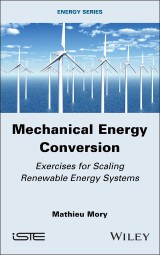Details

Mechanical Energy Conversion
Exercises for Scaling Renewable Energy Systems1. Aufl.
|
126,99 € |
|
| Verlag: | Wiley |
| Format: | EPUB |
| Veröffentl.: | 06.06.2024 |
| ISBN/EAN: | 9781394299058 |
| Sprache: | englisch |
| Anzahl Seiten: | 304 |
DRM-geschütztes eBook, Sie benötigen z.B. Adobe Digital Editions und eine Adobe ID zum Lesen.
Beschreibungen
<p>This book studies the principles of mechanical energy conversion used in renewable energy sources derived from air and water: wind power, tidal power, hydroelectric power, osmotic energy, ocean thermal energy and wave energy.</p> <p><i>Mechanical Energy Conversion</i> presents twelve application exercises and their answers. They enable the reader to first understand the physical principles of mechanical energy converters and then learn the method for sizing them. The book also reinforces the concepts of fluid mechanics and hydraulic turbo machinery, which are required to solve the exercises.</p> <p>This book aims to instruct readers on how to design an energy system. For each renewable energy source covered – and based on the quantity of energy or power supplied – it describes the production process, explains how it works and calculates the characteristics and dimensions of its components.</p>
<p>Foreword ix<br /><i>Jean-Luc ACHARD</i></p> <p>Preface xiii</p> <p>Acknowledgments xv</p> <p>Introduction xvii</p> <p><b>Chapter 1 Revision of Fluid Mechanics 1</b></p> <p>1.1 Euler's equations 1</p> <p>1.2 Head and Bernoulli's theorem 4</p> <p>1.3 Hydrostatics and variation of pressure in a direction perpendicular to a streamline 8</p> <p>1.4 Linear head losses 9</p> <p>1.5 Singular head losses 12</p> <p>1.6 Head variation along a streamline 13</p> <p>1.7 Kinetic energy balance on a fluid volume 14</p> <p>1.8 Momentum theorem 19</p> <p>1.9 Angular momentum theorem 22</p> <p>1.10 Irrotational flows, potential flows 23</p> <p><b>Chapter 2 Hydraulic Turbomachines 25</b></p> <p>2.1 General information on turbomachinery 25</p> <p>2.1.1 Turbopumps and turbines 25</p> <p>2.1.2 Notions of aerodynamics 27</p> <p>2.1.3 Principle of mechanical conversion: force and power, velocity triangle, fixed reference and mobile reference 29</p> <p>2.1.4 Rotor and stator 33</p> <p>2.1.5 Machine with infinite number of blades 34</p> <p>2.1.6 Similarity of Combe--Rateau 35</p> <p>2.1.7 Specific speed and classification of roto-dynamic machines 37</p> <p>2.2 Pump dimensioning 38</p> <p>2.2.1 Classification of roto-dynamic pumps 38</p> <p>2.2.2 Centrifugal pumps 40</p> <p>2.3 Turbine dimensioning 42</p> <p>2.3.1 Classification of roto-dynamic turbines 42</p> <p>2.3.2 Dimensioning of Pelton turbines 45</p> <p>2.4 Exercise: centrifugal pump model 50</p> <p>2.4.1 Solution 55</p> <p>2.5 Exercise: radial flow turbine model 67</p> <p>2.5.1 Solution 70</p> <p><b>Chapter 3 Wind Power 81</b></p> <p>3.1 General 81</p> <p>3.1.1 The wind resource 81</p> <p>3.1.2 Energy conversion by a wind turbine 82</p> <p>3.1.3 The development of the wind power sector in France and in Europe 85</p> <p>3.2 Exercise: flow through a wind turbine -- Betz formula 88</p> <p>3.2.1 Solution 91</p> <p>3.3 Exercise: wind turbine rotor model 97</p> <p>3.3.1 Solution 101</p> <p><b>Chapter 4 Tidal Energy 111</b></p> <p>4.1 General information and status of the sector 111</p> <p>4.2 Exercise: energy model of the Rance plant 118</p> <p>4.2.1 Solution 120</p> <p>4.3 Exercise: sizing a Kaplan turbine 126</p> <p>4.3.1 Solution 129</p> <p>4.4 Exercise: marine current turbines farm and modification of currents 137</p> <p>4.4.1 Solution 141</p> <p><b>Chapter 5 Hydroelectric Power 151</b></p> <p>5.1 Hydroelectric power history and data 151</p> <p>5.2 Exercise: maximum power provided by a hydroelectric power station 155</p> <p>5.2.1 Solution 156</p> <p>5.3 Exercise: dimensioning of a PSH power plant 160</p> <p>5.3.1 Part I -- turbine study 163</p> <p>5.3.2 Part II -- study of pumping 163</p> <p>5.3.3 Part III -- production plants and operation of the hydroelectric power station 164</p> <p>5.3.4 Solution 166</p> <p><b>Chapter 6 Osmotic Energy 175</b></p> <p>6.1 The phenomenon of osmosis 175</p> <p>6.2 Exercise: sizing an electricity production system using osmotic energy 177</p> <p>6.2.1 Solution 182</p> <p>6.3 State of the art of osmotic energy technology 189</p> <p><b>Chapter 7 Ocean Thermal Energy Conversion 193</b></p> <p>7.1 The OTEC process 193</p> <p>7.2 Exercise: sizing an OTEC installation using a closed Rankine cycle 197</p> <p>7.2.1 Sizing of the closed Rankine cycle 197</p> <p>7.2.2 Sizing of heat exchangers 202</p> <p>7.2.3 Sizing of deep sea water pumping and conclusions 213</p> <p>7.3 State of play of the OTEC sector 216</p> <p>7.4 Guide to sizing a heat exchanger 217</p> <p><b>Chapter 8 Wave Energy 223</b></p> <p>8.1 Surface gravity wave theory 223</p> <p>8.1.1 General 223</p> <p>8.1.2 Kinematics of linear surface waves 226</p> <p>8.1.3 Wave energy and energy flow 230</p> <p>8.1.4 Reflection of a wave by a vertical wall 233</p> <p>8.1.5 A laboratory experiment achieving total recovery of the wave energy flow 234</p> <p>8.1.6 Recovery of wave energy by an oscillating flap or by a heaving buoy 235</p> <p>8.2 Exercise: sizing an oscillating flap wave energy converter 237</p> <p>8.2.1 Solution 241</p> <p>8.3 State of play on wave energy recovery 252</p> <p>References 259</p> <p>Index 261</p>
<p><b>Mathieu Mory</b> was a CNRS research fellow at LEGI, Grenoble, France, then a professor at the University of Pau, France. He was also head of the Simulation and Optimization of Energy Systems Master's program.</p>

















